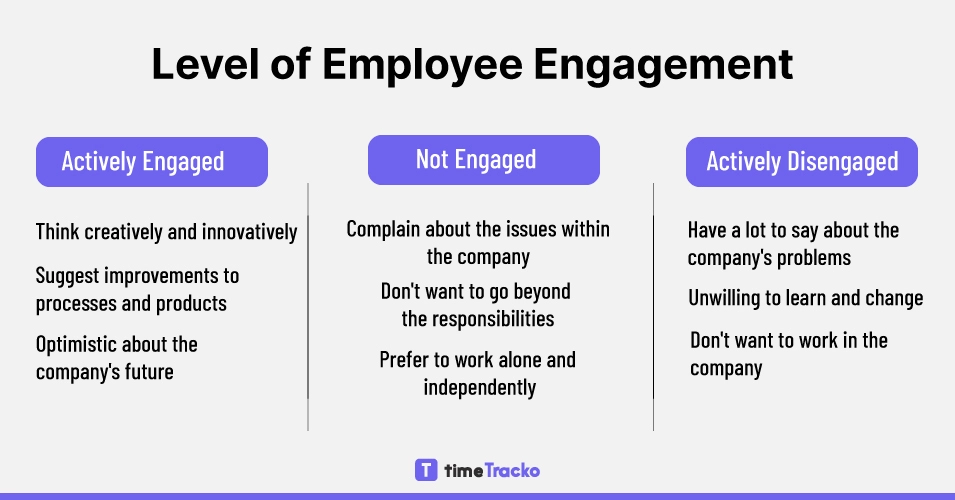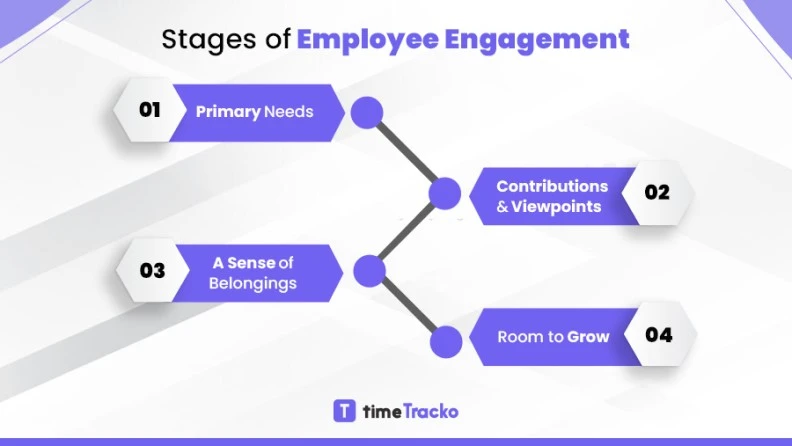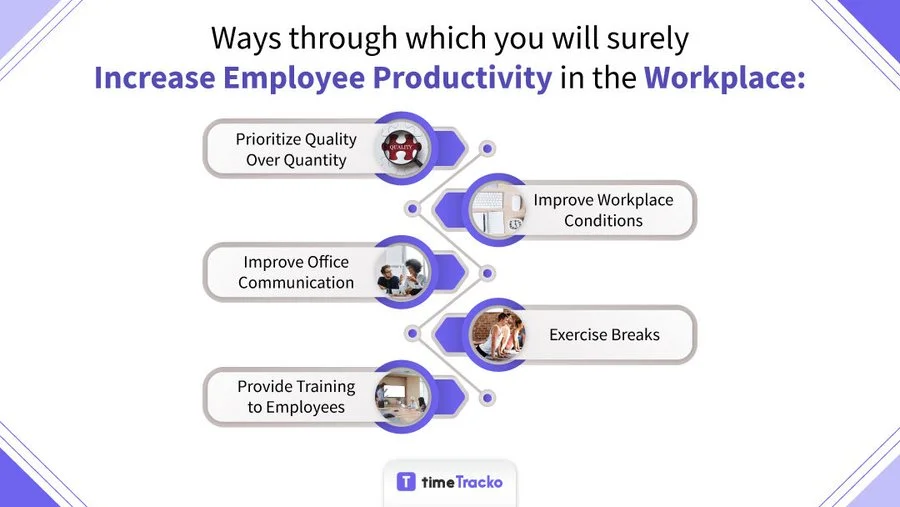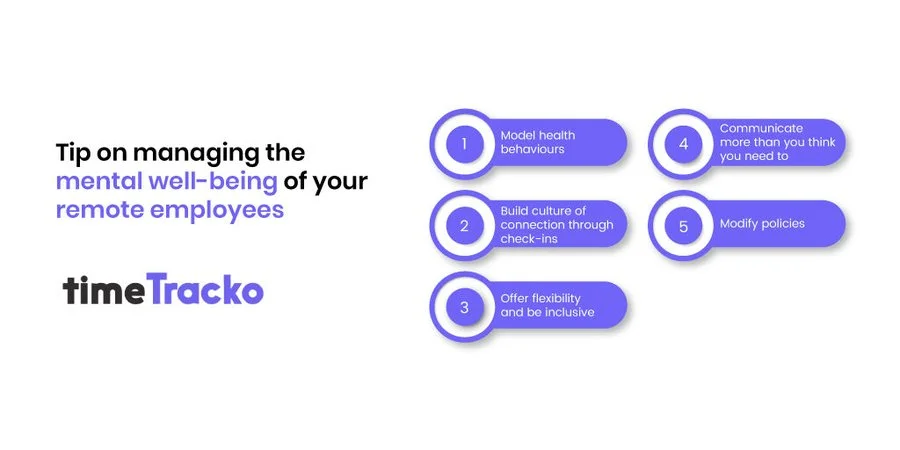Employee Engagement Guide: Stages, Rules, and Tips on How To Improve
Employee Engagement Guide: Stages, Rules, and Tips on How To Improve
Engaged employees work harder, stay longer, and are more motivated to help your organization succeed. Engagement improves profitability, revenue, customer experience, and employee retention.
According to research, 92% of companies believe that engaged employees are more productive, which leads to greater team success and better organisational results.

Defining employee engagement and understanding how it can be achieved is the first step toward driving employee engagement in your organisation.
You can find a wide variety of information regarding the ways to improve employee engagement, some of which are credible and some of which are not. Also, many HR leaders have heard different definitions of employee engagement.
So, let’s find out what employee engagement is and how it can be achieved.
What is Employee Engagement?
The concept of employee engagement refers to a feeling of commitment that an employee has to the company and its goals. This means when employees are engaged, they care about their work and aren’t working just to get a paycheck or the next promotion. As there is saying,
“Highly engaged employees make the customer experience. Disengaged employees break it.” – Timothy R. Clark.
The level of employee engagement is determined by the mental and emotional connections employees have with their work, their teams, and their organisations.
Learn more: What is Employee Engagement? 6 Best Factors of Employee Engagement👫🤝
Level of Employee Engagement
There are three levels of employee engagement described by Gallup’s employee engagement framework.

This measure (level) is intended to provide you with a better understanding of your employees’ commitment and dedication. Levels of engagement are active, not engaged, and actively disengaged.
1. Actively Engaged
Employees who are actively engaged are productive, enthusiastic and committed to their careers and the success of the organisation. Fully engaged employees have more than the mindset to succeed. Moreover, they can produce results that can positively affect your business.
Moreover, these employees demonstrate initiative, passion, creativity, optimism, loyalty, resilience, and a strong work ethic by putting in extra effort and showing their best outcomes.
Identifying actively engaged employees can be done by observing their behaviours, such as:
- They think creatively and innovatively, suggesting improvements to processes and products.
- They take the initiative that helps move the firm forward, rather than waiting for another to do it.
- They are optimistic about the company’s future.
- Their relationships with their supervisors and peers are good. They are well-liked by their colleagues.
2. Not Engaged
An engagement level like this could be viewed as a middle ground. Employees who are not engaged exhibit indifference or neutrality toward their jobs and organisations. As far as their performance is concerned, they’ll only do what is required of them.
Most disengaged employees have overwhelming positive or overwhelmingly negative feelings about their work. Despite their presence, they don’t make an extra effort to move their contribution forward.
Identifying not engaged employees can be done by observing their behaviours, such as:
- On the one hand, they may be complaining about the issues within the company, and on the other, they may be disengaged.
- Their attitude toward the vision and mission of the organisation is negative.
- They don’t want to go beyond the responsibilities or descriptions of their jobs.
- Their preferred method of working is to work alone and independently rather than as part of a team.
Learn more: 10 Best Ways to Motivate Your Employees👨🏫💪
3. Actively Disengaged
There is a negative perception of the workplace among disengaged employees. Their involvement in the organisation does not pertain to its mission, goals, or future. Despite their responsibilities and position, they are not committed to it.
In contrast to engaged workers, actively disengaged ones are negative, cynical, and resentful toward their companies and what they do for a living. They may even sabotage their company’s success for no reason.
Identifying actively disengaged employees can be done by observing their behaviours, such as:
- Their actions and words make it clear they don’t want to work in the company.
- Their behaviour undermines their co-workers, supervisors, and teams in subtle (and not so subtle) ways.
- They have a lot to say about the company’s problems.
- They are unwilling to learn and change, as well as to embrace opportunities for improving the company.
Learn more: Best Employee Engagement Ideas and Activities: Boost Your Team’s Involvement at Work👫👨🏫
Stages of Employee Engagement
Generally speaking, employee engagement is divided into four phases. To increase profitability, organisations must follow these phases in a continuous cycle.

Stage 1: Primary Needs
There are a few basic questions that everyone has to question themselves on their first day on the job, regardless of what position they are hired for.
- How does this role benefit you?
- What are your responsibilities at work?
- Are you provided with the necessary materials and equipment by your company?
Despite its broad and generalising nature, it is an extremely important question for your future success. It will determine how well the organisation and the team will value you. To feel valued in the workplace, every employee’s primary needs need to be addressed to feel valued in the workplace.
Stage 2: Contributions and Viewpoints
The second stage poses questions about one’s worth, feedback, and acknowledgment. If you do not feel like putting in extra effort, you may be dissatisfied with your current position or lack support from the fulfilment department.
And suppose you feel that you are performing your job properly, or you may even be going beyond the call of duty. In that case, however, your company may not acknowledge or provide feedback regarding your performance.
To feel engaged at work, both sides are crucial. To find out what’s wrong, ask yourself the following questions:
- Is your work environment conducive to doing what you do best?
- Have you been praised or recognised for your work in the last seven days?
- Are you feeling cared for by your supervisor?
- What kind of development support do you receive at work?
Stage 3: A Sense of Belongings
After passing the first two levels in the hierarchies, an employee’s attention shifts to the company they keep. At this point, one begins to wonder if the co-workers and environment are a good fit for them and if they are happy with their relationships.
While your role may be vital to an organisation, it’s equally important that you feel a sense of belonging; communicate well with your teammates, and are proud of your work.
The following questions will help you determine whether you belong in this office.
- Does your opinion matter at work?
- Is your job important to your company’s mission/purpose?
- Can you rely on your colleagues (other employees) to do a good job?
- Do you have a best friend or good friend at work?
Learn more: Best Tips to Reduce Absenteeism in the Workplace✍📑
Stage 4: Room to Grow
A major focus of Stage 4 is long-term sustainability. Do you feel your organisation will support you in your current position and help you grow and/or advance?
Does your organisation have a system for expressing your ideas and executing them? The feeling of stagnation in your job can often lead to a decline in your desire to perform at all levels since there is a gap between your motivation and the possibilities defined by your employer.
- Have you been consulted about your progress at work in the last six months?
- How have you grown and learned over the last year?
Why is Employees Engagement Important?
A high level of engagement among your employees is crucial to your company’s success as it leads to greater productivity, better relationships with customers, and higher profits. Highly engaged employees can also become the best advocates for your company.
In a recent study, 92% of business executives concluded that engaged employees boost the success of their teams and businesses.
Here are the top 5 reasons why employee engagement is important.
1. Engaged Employees Boost Productivity
A motivated and invested employee is more likely to be productive than one who isn’t. According to a Gallup poll, Employees who are more engaged are 21% more effective than those who are less engaged.

The level of employee engagement can measure an organisation’s success. In general, employees who feel valued by their employer are more likely to come to work with a positive attitude and with a sense of excitement.
Thus, engaging your employees, challenging them or giving them more responsibilities boosts your organisation’s productivity.
Learn more: Impact of Employee Engagement on Productivity👨💻📈
2. Employee Engagement Increases Customer Satisfaction
Passion is contagious, so the passion you display will be evident to your customers. People who are passionate about what they do are the best people to interact with them.
Engagement leads to better product pitches, more productive salespeople, and happier sales managers since customers are more likely to be satisfied if they feel valued by the organisation and believe it is important to help them.
Learn more: Best Tips to Enhance Employee Satisfaction That Leads to Better Productivity!🙌🤗
3. You’ll Retain Your Best People
The better engaged your workers are, the more likely they will be to stick with your company and stay in their roles. The better engaged your employees are, the more likely they are to remain in your company, therefore, the better your company will be at retaining them.
When your organisation experiences low retention rates, you need to identify the root cause of their disengagement. In a nutshell, you don’t want your best employees to leave, which can cause a domino effect throughout your company.
Learn more: Best Strategies For Great Employee Retention👫👫
4. Employee Engagement Enhances Company Culture
The reason engaged employees are easier to work with, in general, is that they are exemplifying employee engagement rather than being happier or more cheerful.
Engagement occurs when employees live the values of your organisation every day at work and are recognised for it across the organisation. Creating a culture of engagement begins with celebrating your most engaged employees.
5. Engagement is a Symptom of Success
The level of engagement is a measure of success, which is not necessarily the result of a successful organisation. Rather, engagement usually reflects the success of an individual or team.
Engagement is not based on productivity or ease of working but on the perception that their work matters and that they feel valued. Thus, recognising your employee’s accomplishments will make them feel like they’ve made a positive impact at work.
Tips to Improve Employee Engagement At Work
The following tips can help you maintain your company culture and make your virtual staff feel like they are truly part of it.
1. Clarify Goals
There are several goals and responsibilities that every employee needs to focus on or work on. An employee’s role in an organisation can sometimes be misunderstood or mixed up, which is quite common. Increasing employee engagement within your organisation requires clarifying goals and responsibilities.
If you want your employees to feel engaged in your organisation, you need to show them you are there to help them set goals and deal with problems as they arise.
Make your training program more interactive by organizing workshops and conferences and inviting guest speakers in your industry. This not only increases your employees’ productivity but also boosts their morale.
2. Provides Workers With Appropriate Tools
Employers can improve employee engagement, productivity, and job satisfaction by equipping them with the proper tools.
The best way to improve workplace engagement is to promote employee well-being. A structured well-being program can provide targeted activities tailored to the needs of each employee.
Learn more: Best Employee Engagement Software💻👩💻
3. Train Your Employee to Succeed in Their Role and Beyond
Providing employees with clear development opportunities will help improve employee retention. According to Gallup, “The most common reason for changing jobs is to pursue career advancement.”
Don’t give your employees reasons to leave your organization; instead, encourage them to grow within it. An integral component of employee engagement is commitment.
Consider the following additional ways to encourage employees to share their unique motivations, skills, and interests:
- Learn about employees’ career goals and care about them.
- Organise interdepartmental meetings to discover cross-training or development opportunities.
- Develop employees and announce new job openings within the organisation.
- Motivate managers to ensure employees’ growth, even if it means transitions.
4. Provide Feedback
A good internal communication system makes employees feel valued at work. Their ideas are well received, recognised, and heard, and they effectively collaborate with other teams. The key to achieving this is to encourage a culture of consistent, two-way communication.
- Make it easy for employees to share honest feedback.
- Make important decisions informed to employees.
- Lead by showing you understand what’s happening.
- Show genuine concern for your employees.
The more open communication is made, the more likely employees will seek regular feedback and communicate openly with you.
5. Recognize and Reward Your Employee
Authentic appreciation from peers, managers, and leaders enables employees to feel fully engaged in the organisation. They are also motivated to work hard when recognised for their efforts.
Recognising your employees can be as simple as these suggestions:
- Achieve milestones, celebrate ideas, and celebrate completed projects.
- Avoid celebrating things that only benefit a few while others struggle.
- Ensure that every success is celebrated.
- Give credit to individuals or teams.
- Be sure to emphasise that feedback inspired the action.
6. Foster Interaction and Communication
Communication is a key factor to consider when assessing how to improve employee engagement. After all, communication is at the core of everything we do in our daily lives, especially at work. It determines our ability to work successfully and our engagement with others.
Also, the more remote employees know you care about them individually and professionally, the more engaged and committed they will be to the company and their roles. After all, we all rely on communication daily, and this is especially true at work.
7. Reiterate the Company’s Vision
Taking action in this manner will help ensure that everyone works towards the same goal and that each employee feels invested in the company’s success.
Several methods can be used to accomplish this:
- Maintain regular progress meetings to keep everyone informed.
- Ensure that all employee communications, such as company newsletters and websites, reflect the company’s vision.
- Remind everyone of the company’s goals by posting signs or posters around the office.
8. Promote Healthy Work Habits
Maintain a healthy work environment in the workplace. Promoting taking breaks while at work will improve employee morale and prevent overwork and burnout, resulting in a more productive workday.
Offering a flexible work schedule, ensuring a comfortable workplace, and encouraging work-life balance can all go a long way in showing your employees you care for their wellbeing.
Learn more: Effects of Working in an Unhealthy Work Environment🤕👩💻
9. Provide Working Flexibility
The trend toward flexible working is gaining traction rapidly. Remote work opportunities and flexible work schedules are almost guaranteed ways to engage employees. Most employees (87%) expect their employers to assist them in balancing their work obligations with their responsibilities.
Employees can change their working hours or mark a day off on their intranet. Also, an intranet calendar can keep track of meetings, appointments, events, birthdays and who is out of the office.
10. Encourage Health and Wellness
Keeping the health of your employees in mind should be the top priority. When an employee is ill, he or she will not be able to perform at their best or even at all. Create incentives to encourage your team to get outside, eat healthy, exercise, or form healthy habits.

In addition to helping your workers improve their health, an employee wellness program will also bring them together and demonstrate your concern for their well-being.
What Employee Engagement is Not?
Employee engagement consists of more than motivation or job satisfaction.
Employee Engagement is not motivation: Engagement and motivation are distinct concepts. A person may be highly motivated to accomplish a task, but unengaged in its implementation.
Employee engagement is not satisfaction: There is a difference between engagement and satisfaction. Employees must be passionate about their work, and have a can-do attitude, while employers should create an environment where great work flourishes.
Employee engagement is not happiness: Despite the fact that engaged workers tend to be happier, happiness itself is not indicative of employee engagement. For employee engagement to be successful, it must be a cross-departmental, collective vision that flows throughout the entire organization.
Employee engagement is not only about employees: The engagement of employees does not stop after hours. After hours, employees engage in a wide variety of roles, including spouses, parents, community leaders, and caregivers. Offering your employees flexible work arrangements, health insurance, and wellness initiatives reflect your commitment to their families.
Employee Engagement in HR
Increasing employee engagement involves improving employee emotions and feelings about their workplace, their job duties, their positions within the company, and their colleagues. To improve productivity and well-being within an organization, HR departments can use employee engagement tactics.
Through employee engagement, the company’s mission, goals, and values will be maintained and employees will remain motivated, inspired, and fully committed.
In order to improve employee engagement, HR departments should fulfil five key roles.
1. Executive Leadership
In order to improve employee engagement, HR departments should play a leadership role in identifying and implementing better engagement strategies. Also, they should make sure employees know what to expect from the organization.
2. Employee Engagement
It is important that HR professionals within the organization focus on employee engagement. HR professionals are the ones who understand the importance of employee engagement in HR, which employee engagement tactics work best, and how to measure them.
3. Training
HR managers should also receive training, guidance, and coaching to improve employee engagement. HR leaders should establish an open dialogue, address issues hindering employee engagement, acknowledge and applaud employee success, and strive to improve performance beyond scores and metrics.
4. Activities
The HR department plays a vital role in employee engagement, but they also have a duty to bring enthusiasm, excitement, and inspiration to the process as a humorist. HR can promote a productive workplace by introducing, implementing, and organizing employment engagement activities.
5. Measurement
For employee engagement to be successful, HR must serve as the gatekeeper. A human resources professional can create and implement specific action plans that are discussed frequently with team managers and addressed via surveys, department check-ins, and other methods.
HR departments should focus on specific dialogues and methods that positively influence employee engagement rather than concentrating solely on data, analytics and benchmark goals.
Moreover, employers can also use employee tracking software such as timeTracko to measure and analyse employee engagement within the organisation.
Conclusion
There is not any hard and fast rule to increase employee engagement in the workplace. To make your employees’ time at work more productive and fruitful, simply ask them what needs to be improved. You might be surprised by the simple solution.
FAQs
Q1) What are 3 key points to an engaged workforce?
The main 3 key points to an engaged workforce are leadership, rewards and recognition, and professional growth.
Q2) What are the top 5 drivers of employee engagement?
Employee engagement is driven by five key factors:
Engaging leaders
Opportunities for learning and development
Relationship with co-workers
Employee voice and integrity
Strategic Narrative (leadership)
Q3) How to measure employee engagement?
There are some tips that help to measure employee engagement.
Establish clear employee engagement goals
Check employee retention
Look at employee productivity
Absenteeism
Identify what’s important to your employee

 in Melbourne
in Melbourne 
 Employee Screen Monitoring Software
Employee Screen Monitoring Software App and Website Monitoring Software
App and Website Monitoring Software Time and Attendance Software
Time and Attendance Software Finance
Finance Banking
Banking Healthcare
Healthcare Lawyers
Lawyers Retail & ecommerce
Retail & ecommerce Knowledge base
Knowledge base Blogs
Blogs Installation Guide
Installation Guide FAQs
FAQs About
About Media Kit
Media Kit Contact us
Contact us